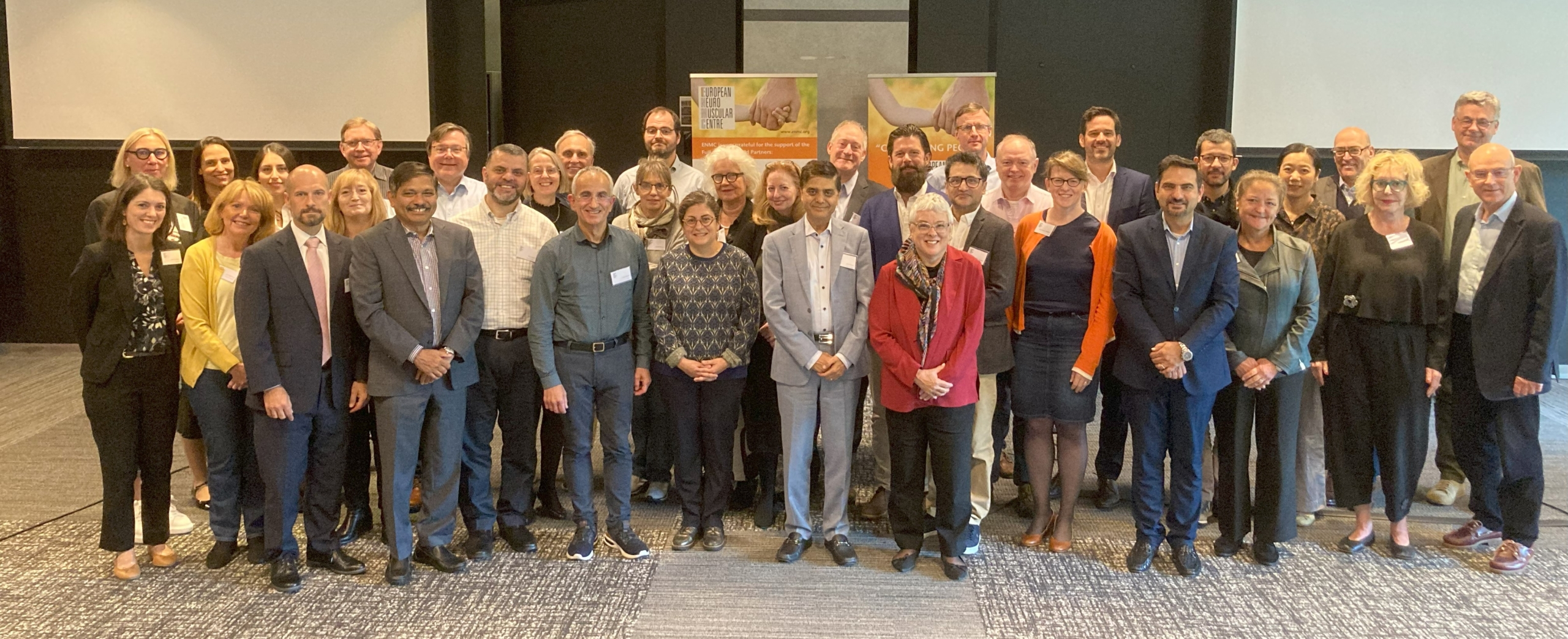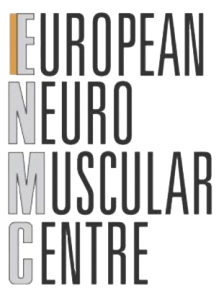Assessing and managing emerging AAV-related toxicities after gene therapy for neuromuscular disorders
- Number 289
- Date 26 September 2025
289th ENMC International workshop
Location: Hoofddorp, The Netherlands
Title: Assessing and managing emerging AAV related toxicities after AAV gene therapy for neuromuscular disorders
Date: 26th-28th September 2025
Organisers: Prof. Carsten Bönnemann (USA), Prof. Hildegard Büning (Germany) and Prof. Francesco Muntoni (UK).
Early Career Researchers: Dr Rotem Orbach (USA) and Dr Rebeca Gil (UK)
Translations of this report by:
German by Hildegard Büning
French by Serge Braun
Italian by Francesco Muntoni
Dutch by Elizabeth Vroom
Spanish by Rebeca Gil
Finnish by Anna Kajaste-Rudnitski
Hebrew by Rotem Orbach
Arabic by Basel Assaf
Participants:
Dr Carsten Bönnemann (USA); Dr Hildegard Büning (Germany); Dr Basel Assaf (USA); Ms Katherine Beaverson (patient representative, USA); Dr Serge Braun (France); Dr Gabriel Brooks (USA); Dr Barry Byrne (USA); Dr Ana Buj-Bello (France); Dr Jeff Chamberlain (USA); Dr Nas Dastgir (USA); Dr Anil Dhawan (UK); Dr Kevin Flanigan (USA); Ms Pat Furlong (patient representative, USA); Dr Amitava Ganguli (UK); Dr Rebeca Gil (UK); Dr Jan Kirschner (Germany); Dr Bradley Hamilton (USA); Dr Sharon Hesterlee (patient representative, USA); Dr Juliette Hordeaux (USA); Dr Anna Kajaste-Rudnitski (Italy); Dr Rohit Kohli (USA); Dr Genevieve Laforet (USA); Dr. Dan Levy (USA); Dr Hugh McMillian (Canada); Dr Yanis Mimouni (France); Dr Francesco Muntoni (UK); Dr Alex Murphy (Switzerland); Dr Kanneboyina Nagaraju (USA); Dr Ros Quinlivan (UK); Dr Rotem Orbach (USA); Dr James Richardson (USA); Dr Isabelle Richard (France); Dr Giuseppe Ronzitti (France); Dr Ulrike Schara-Schmidt (Germany); Dr Jonathan Schwartz (USA); Dr Qi Shen (USA); Ms Elizabeth Vroom (patient representative, The Netherlands); Dr Karim Wahbi (France).
Summary:
The 289th ENMC workshop was held from the 26th to the 28th of September 2025, and brought together 38 representatives of advocacy groups, industry, neuromuscular preclinical and clinical experts from Europe and the United States.
Adeno-associated viral (AAV) mediated gene therapy is a very powerful technology that has the potential to significantly improve quality of life of patients affected by a variety of neuromuscular conditions. A number of products have already been approved in gene therapy in general and others are at different stages of clinical development. Regarding neuromuscular disorders, two products received regulatory approval, AAV9-SMN gene therapy (onasemnogene abeparvovec, ZolgensmaÒ) for spinal muscular atrophy (SMA), which has been commercially administered to more than 10,000 patients worldwide ; and AAV-Rh74 microdystrophin gene therapy (delandistrogene moxeparvovec-rokl, Elevidys) for Duchenne Muscular Dystrophy (DMD), which received in 2024 FDA approval in the United States. Several publications have highlighted the benefits of these and other emerging therapies in managing neuromuscular disorders, with clear benefits in SMA for Zolgensma, in DMD patients for Elevidys and in children affected by Myotubular Myopathy treated with AAV8 vector containing the missing MTM1 gene (resamirigene bilparvovec). Nevertheless, a range of severe adverse events have been observed in clinical trials and emerged in the real-world use of these novel products. These included several complications affecting the blood, the heart, and the liver, some of which were fatal while others resolved with no long term complications. In order to continue the development of these products and improve their risk/benefit profile, the workshop was devoted to openly and collaboratively review recent findings related to those severe adverse events. The discussion included learnings about their spectrum of manifestations and causation, the role of different research models in helping to understand the process that causes them, and the potential effectiveness of existing treatments that work on the immune system in preventing or mitigating these adverse events. Novel and emerging manifestations of toxicity related to AAV gene therapy in the human were also reported, and the effect of different therapeutic modalities discussed.
Four dedicated working groups diligently worked in the last 6 months leading up to the meeting with several teleconferences to prepare the groundwork for the workshop. These 4 working groups focused on: 1. Anti-transgene adverse events; 2. Thrombotic microangiopathy; 3. Liver related adverse events; 4. Cardiac related adverse events.
The presentations and discussions at the meeting followed the topics identified in the 4 working groups, and in particular:
- Anti-transgene adverse events: update on any novel anti-transgene related adverse events, i.e, the rejection of the new protein made from the transgene by the recipient’s own immune system, as sometimes, the body recognizes the transgene product, the protein made by this new gene, as foreign. This review focused on the long term outcomes of previously reported events, the role of different immunosuppressive regimens and the theoretical possibility of smoldering, low grade forms of rejection. Comprehensive discussion was focused on the need to characterize thoroughly these events using detailed and advanced laboratory methods such as histology, histochemistry and immunohistochemistry to allow to distinguish the rejection reaction from ongoing baseline disease pathology, and to develop strategies to help the immune system to tolerate the therapeutic gene.
- Thrombotic microangiopathy: The clinical manifestations of thrombotic microangiopathy impact the blood, blood vessels, and clotting systems in various organs. Focus was placed on the body's first line of defense, known as innate immunity, which is a non-specific immune response to foreign agents that enter the body, such as the AAV vector. Factors that may trigger this adverse event include the specific AAV vector capsids used, the dosage, and the presence of other nucleic acids that could potentially contaminate the treatment. The discussion also included various immune-suppressing treatments that have been, or could be, used to prevent or manage these complications.
- Liver related adverse events: The AAV administered systemically into the vein at high doses will first encounter the liver which then might engage early innate immunity response, or later a directed (“adaptive”) immune respose against the AAV capsid still present in the liver. Specific attention was placed on the potentially extremely severe adaptive immune response that recently lead to the demise of the patients with neuromuscular disorders. The discussion focused on how to identify and risk-stratify patients ahead of the AAV gene therapy; and immunosuppressive regimens that could be considered in these rapidly evolving medical emergencies. It was stressed multiple times that there is an incomplete understanding of the dynamics of these events and that further knowledge should be acquired by considering liver biopsies for patients in whom severe liver involvement is observed or are at high risk.
- Cardiac related adverse events: The discussion was focused specifically on the learning from two individuals affected by DMD, who died within the first week of gene therapy administration, highlighting that there might be a complex interplay with overwhelming early innate immune response, also leading to interstitial lung disease. In one case, the autopsy helped explain this poorly understood complication that can occur after AAV gene therapy.
In a separate session, several presentations focused on understanding of specific clinical complications that are only now emerging or being recognized following AAV gene therapy, including a potentially severe multisystemic condition referred to as capillary leak syndrome. Here, it was important to understand how existing disease-related changes, such as baseline inflammation or blood vessel damage, might make these side effects worse, contribute to them or even trigger them. We also discussed new laboratory methods to assess a person’s immune system before gene therapy and to predict how their immune system responds afterward.
The last part of the meeting addressed the need to revise and share standard operating procedures and clinical guidelines on collacting data around these events. Those efforts will allow better assessment of whether each individual is a good candidate for AAV treatment and their personal level of risk before receiving an AAV gene therapy. Most importantly the value of openly sharing and comparing data on these emerging challenges associated with AAV mediated gene therapy on a pre-competitive level was recognized and strategies for effective data collection and sharing were discussed.
Multiple future collaborative options were agreed, ranging from registries of patients treated with these therapies to future working groups and meetings to continue the refinement of protocols for monitoring and management of the more common adverse events. One of the major takeaways from the meeting was that we are now establishing a collaborative framework to deeply understand the implications of using AAV as a therapeutic vector in human and to develop rational approaches to address the inherent challenges and toxicities proactively and in an individual patient centered fashion so that the potential benefits of this still young but potentially revolutionary therapeutic concept can be fully realized.
A full report of the conference is currently under preparation and will be published in Neuromuscular Disorders.

